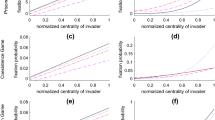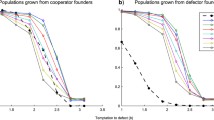Abstract
Understanding how cooperation spreads across social groups is fundamental in predicting how people will interact with each other in relation to the use and exploitation of the resources they are provided with. When social interactions can be mapped to a network, questions arise about the impact of the connection structure which can benefit from the literature developed for a dynamical systems. One model that is widely used as a model to understand the dynamics of cooperation is the replicator equation. While research has been proposed to adapt that equation to a structured graph, we offer a straightforward approach by benefiting from the networked SI diffusion model and replicator equation to create a replicator equation on a network with state-dependent diffusive constant. This approach can be applied to any network structure and features separation of the game and the information diffusion mechanism. The equilibria towards which the system evolves are here characterised and discussed.
Access this chapter
Tax calculation will be finalised at checkout
Purchases are for personal use only
Similar content being viewed by others
References
Bullo, F.: Lectures on Network Systems (2018)
Cassese, D.: Replicator equation on networks with degree regular communities. Appl. Network Sci. 3, 29 (2018). https://doi.org/10.1007/s41109-018-0083-2
Das, S., Eksin, C.: Approximate submodularity of maximizing anticoordination in network games. In: 2022 IEEE 61st Conference on Decision and Control (CDC), pp. 3151–3157 (2022). https://doi.org/10.1109/CDC51059.2022.9993180
Du, J., Wu, Z.: Evolutionary dynamics of cooperation in dynamic networked systems with active striving mechanism. Appl. Math. Comput. 430, 127295 (2022). https://doi.org/10.1016/J.AMC.2022.127295
Ghivarello, S., Antonioni, A.: Coevolution of individual perception and cooperative behavior in the norm compliance dilemma (2022)
Hilbe, C.: Local replicator dynamics: a simple link between deterministic and stochastic models of evolutionary game theory. Bull. Math. Biol. 73, 2068–2087 (2011). https://doi.org/10.1007/s11538-010-9608-2
Li, J.Y., Wu, W.H., Li, Z.Z., Wang, W.X., Zhang, B.: Data-driven evolutionary game models for the spread of fairness and cooperation in heterogeneous networks. Front. Psychiatry 14, 1131769 (2023). https://doi.org/10.3389/fpsyt.2023.1131769
Lleberman, E., Hauert, C., Howak, M.A.: Evolutionary dynamics on graphs. Nature 433, 312–316 (2005). https://doi.org/10.1038/nature03204
Mieghem, P.V., Omic, J., Kooij, R.: Virus spread in networks. IEEE/ACM Trans. Networking 17, 1–14 (2009). https://doi.org/10.1109/TNET.2008.925623
Nowak, M.A., May, R.M.: Evolutionary games and spatial chaos. Nature 359, 826–829 (1992). https://doi.org/10.1038/359826a0
Ohtsuki, H., Nowak, M.A.: The replicator equation on graphs. J. Theor. Biol. 243, 86–97 (2006). https://doi.org/10.1016/j.jtbi.2006.06.004
Perc, M., Gómez-Gardeñes, J., Szolnoki, A., Floría, L.M., Moreno, Y.: Evolutionary dynamics of group interactions on structured populations: a review. J. R. Soc. Interface 10, 20120997 (2013). https://doi.org/10.1098/rsif.2012.0997
Perc, M., Jordan, J.J., Rand, D.G., Wang, Z., Boccaletti, S., Szolnoki, A.: Statistical physics of human cooperation. Phys. Rep. 687, 1–51 (2017). https://doi.org/10.1016/j.physrep.2017.05.004
Requejo, R.J., Díaz-Guilera, A.: Replicator dynamics with diffusion on multiplex networks. Phys. Rev. E 94, 022301 (2016). https://doi.org/10.1103/PhysRevE.94.022301
Riehl, J.R., Cao, M.: Towards control of evolutionary games on networks. In: 53rd IEEE Conference on Decision and Control, pp. 2877–2882 (2014). https://doi.org/10.1109/CDC.2014.7039831
Riehl, J.R., Cao, M.: Towards optimal control of evolutionary games on networks. IEEE Trans. Autom. Control 62, 458–462 (2017). https://doi.org/10.1109/TAC.2016.2558290
Santos, F.C., Pacheco, J.M.: Scale-free networks provide a unifying framework for the emergence of cooperation. Phys. Rev. Lett. 95, 098104 (2005). https://doi.org/10.1103/PhysRevLett.95.098104
Szolnoki, A., Perc, M.: Reward and cooperation in the spatial public goods game. Europhys. Lett.=Europhys. Lett. 92, 38003 (2010). https://doi.org/10.1209/0295-5075/92/38003
Tan, S., Wang, Y.: Graphical nash equilibria and replicator dynamics on complex networks. IEEE Trans. Neural Networks Learn. Syst. 31, 1831–1842 (2020). https://doi.org/10.1109/TNNLS.2019.2927233
Taylor, P.D., Jonker, L.B.: Evolutionary stable strategies and game dynamics. Math. Biosci. 40, 145–156 (1978). https://doi.org/10.1016/0025-5564(78)90077-9
Veelen, M.V.: The replicator dynamics with n players and population structure. J. Theor. Biol. 276, 78–85 (2011). https://doi.org/10.1016/j.jtbi.2011.01.044
Wang, S., Chen, X., Xiao, Z., Szolnoki, A.: Decentralized incentives for general well-being in networked public goods game. Appl. Math. Comput. 431, 127308 (2022)
Acknowledgement
This work funding was supported by Puslapdik BPI (Pusat Layanan Pendidikan Beasiswa Pendidikan Indonesia) Ministry of Education, Culture, Research and Technology of Indonesia, LPDP (Lembaga Pengelola Dana Pendidikan) Ministry of Finance of Indonesia, and Telkom University.
Author information
Authors and Affiliations
Corresponding author
Editor information
Editors and Affiliations
Rights and permissions
Copyright information
© 2024 The Author(s), under exclusive license to Springer Nature Switzerland AG
About this paper
Cite this paper
Aurachman, R., Punzo, G. (2024). On the Relation Between Replicator Evolutionary Dynamics and Diffusive Models on General Networks. In: Cherifi, H., Rocha, L.M., Cherifi, C., Donduran, M. (eds) Complex Networks & Their Applications XII. COMPLEX NETWORKS 2023. Studies in Computational Intelligence, vol 1142. Springer, Cham. https://doi.org/10.1007/978-3-031-53499-7_29
Download citation
DOI: https://doi.org/10.1007/978-3-031-53499-7_29
Published:
Publisher Name: Springer, Cham
Print ISBN: 978-3-031-53498-0
Online ISBN: 978-3-031-53499-7
eBook Packages: EngineeringEngineering (R0)




